The Effects of Spill Pressure on the Migration and Remediation of Dense Non-Aqueous Phase Liquids in Homogeneous and Heterogeneous Aquifers
Abstract
:1. Introduction
2. Materials and Methods
2.1. Modeling DNAPL Releasing with Different Spill Pressures in a Contaminated Aquifer
2.2. Implementing the Surfactant-Enhanced Aquifer Remediation
2.3. Quantifying the Permeability and Entry Pressure
2.4. Dealing with the Heterogeneity of Porous Media
3. Results and Discussion
3.1. The Effect of Spill Pressure on DNAPL Migration and Remediation in the Homogeneous Aquifer
3.2. The Effect of Spill Pressure on DNAPL Behaviors in the Heterogeneous Aquifer
4. Conclusions
Supplementary Materials
Author Contributions
Funding
Data Availability Statement
Conflicts of Interest
References
- Ibrahim, S.I.; Yadav, P.K.; Dwiandani, A.; Liedl, R.; Dietrich, P. An approach for quantification of the heterogeneity of DNAPL source zone geometries. J. Contam. Hydrol. 2022, 251, 104096. [Google Scholar]
- Valletti, N.; Budroni, M.A.; Albanese, P.; Marchettini, N.; Sanchez-Dominguez, M.; Lagzi, I.; Rossi, F. Hydrodynamically-enhanced transfer of dense non-aqueous phase liquids into an aqueous reservoir. Water Res. 2023, 231, 119608. [Google Scholar] [PubMed]
- Feo, A.; Celico, F.; Zanini, A. Migration of DNAPL in Saturated Porous Media: Validation of High-Resolution Shock-Capturing Numerical Simulations through a Sandbox Experiment. Water 2023, 15, 1471. [Google Scholar] [CrossRef]
- Maire, J.; Fatin-Rouge, N. Surfactant foam flushing for in situ removal of DNAPLs in shallow soils. J. Hazard. Mater. 2017, 321, 247–255. [Google Scholar] [CrossRef] [PubMed]
- Wu, M.; Cheng, Z.; Wu, J.F.; Wu, J.C. Quantifying representative elementary volume of connectivity for translucent granular materials by light transmission micro-tomography. J. Hydrol. 2017, 545, 12–27. [Google Scholar] [CrossRef]
- Lin, K.S.; Mdlovu, N.V.; Chen, C.Y.; Chiang, C.L.; Dehvari, K. Degradation of TCE, PCE, and 1,2–DCE DNAPLs in contaminated groundwater using polyethylenimine-modified zero-valent iron nanoparticles. J. Clean. Prod. 2018, 175, 456–466. [Google Scholar]
- Tatti, F.; Papini, M.P.; Sappa, G.; Raboni, M.; Arjmand, F.; Viotti, P. Contaminant back-diffusion from low-permeability layers as affected by groundwater velocity: A laboratory investigation by box model and image analysis. Sci. Total Environ. 2018, 622–623, 164–171. [Google Scholar] [CrossRef]
- Baldwin, B.R.; Taggart, D.; Chai, Y.Z.; Wandor, D.; Biernacki, A.; Sublette, K.L.; Wilson, J.T.; Walecka-Hutchison, C.; Coladonato, C.; Goodwin, B. Bioremediation Management Reduces Mass Discharge at a Chlorinated DNAPL Site. Groundw. Monit. Remediat. 2017, 37, 58–70. [Google Scholar] [CrossRef]
- Cianflone, S.P.L.; Dickson, S.E.; Mumford, K.G. On the Importance of Gravity in DNAPL Invasion of Saturated Horizontal Fractures. Groundwater 2017, 55, 27–37. [Google Scholar] [CrossRef]
- Kim, H.J.; Leitch, M.; Naknakorn, B.; Tilton, R.D.; Lowry, G.V. Effect of emplaced nZVI mass and groundwater velocity on PCE dechlorination and hydrogen evolution in water-saturated sand. J. Hazard. Mater. 2017, 322, 136–144. [Google Scholar]
- Mo, L.T.; Ye, S.J.; Wu, J.C.; Stahl, R.G., Jr.; Grosso, N.R.; Wang, J.C. Field application at a DNAPL-contaminated site in Nanjing and discussion of a source search algorithm based on stochastic modeling and Kalman filter. Environ. Earth Sci. 2017, 76, 92. [Google Scholar] [CrossRef]
- Maire, J.; Joubert, A.; Kaifas, D.; Invernizzi, T.; Marduel, J.; Colombano, S.; Cazaux, D.; Marion, C.; Klein, P.Y.; Dumestre, A.; et al. Assessment of flushing methods for the removal of heavy chlorinated compounds DNAPL in an alluvial aquifer. Sci. Total Environ. 2018, 612, 1149–1158. [Google Scholar] [CrossRef] [PubMed]
- Feng, C.; Liu, F.; Huang, F.Y.; Chen, L.P.; Bi, E.P. Dense nonaqueous phase liquids back diffusion controlled by biodegradation and heterogeneous sorption-desorption. J. Clean. Prod. 2023, 382, 135370. [Google Scholar]
- Wang, Z.B.; Lu, W.X.; Chang, Z.B.; Luo, J.N. A combined search method based on a deep learning combined surrogate model for groundwater DNAPL contamination source identification. J. Hydrol. 2023, 616, 128854. [Google Scholar] [CrossRef]
- Khasi, S.; Fayazi, A.; Kantzas, A. Break-up and mobilization of DNAPL by acoustic excitation: Experimental evidence and pore network modeling. Chemosphere 2023, 325, 138345. [Google Scholar] [CrossRef] [PubMed]
- Feo, A.; Pinardi, R.; Artoni, A.; Celico, F. Three-Dimensional High-Precision Numerical Simulations of Free-Product DNAPL Extraction in Potential Emergency Scenarios: A Test Study in a PCE-Contaminated Alluvial Aquifer (Parma, Northern Italy). Sustainability 2023, 15, 9166. [Google Scholar] [CrossRef]
- Erning, K.; Grandel, S.; Dahmke, A.; Schäfer, D. Simulation of DNAPL infiltration and spreading behaviour in the saturated zone at varying flow velocities and alternating subsurface geometries. Environ. Earth Sci. 2012, 65, 1119–1131. [Google Scholar] [CrossRef]
- Marzougui, S.; Schäfer, G.; Dridi, L. Prediction of Vertical DNAPL Vapour Fluxes in Soils Using Quasi-Analytical Approaches: Bias Related to Density-Driven and Pressure-Gradient-Induced Advection. Water Air Soil Pollut. 2012, 223, 5817–5840. [Google Scholar]
- McMillan, L.A.; Rivett, M.O.; Wealthall, G.P.; Zeeb, P.; Dumble, P. Monitoring well utility in a heterogeneous DNAPL source zone area: Insights from proximal multilevel sampler wells and sampling capture-zone modelling. J. Contam. Hydrol. 2018, 210, 15–30. [Google Scholar] [CrossRef]
- Wu, M.; Wu, J.F.; Wu, J.C.; Hu, B.X. A three-dimensional model for quantification of the representative elementary volume of tortuosity in granular porous media. J. Hydrol. 2018, 557, 128–136. [Google Scholar]
- Cochennec, M.; Davarzani, H.; Davit, Y.; Colombano, S.; Ignatiadis, I.; Masselot, G.; Quintard, M. Impact of gravity and inertia on stable displacements of DNAPL in highly permeable porous media. Adv. Water Resour. 2022, 162, 104139. [Google Scholar] [CrossRef]
- Omirbekov, S.; Colombano, S.; Alamooti, A.; Batikh, A.; Cochennec, M.; Amanbek, Y.; Ahmadi-Senichault, A.; Davarzani, H. Experimental study of DNAPL displacement by a new densified polymer solution and upscaling problems of aqueous polymer flow in porous media. J. Contam. Hydrol. 2023, 252, 104120. [Google Scholar] [PubMed]
- Wang, Y.; Bian, J.; Sun, X.; Ruan, D.; Gu, Z. Sensitivity-dependent dynamic searching approach coupling multi-intelligent surrogates in homotopy mechanism for groundwater DNAPL-source inversion. J. Contam. Hydrol. 2023, 255, 104151. [Google Scholar]
- Herzog, B.M.; Kleinknecht, S.M.; Haslauer, C.P.; Klaas, N. Experimental upscaling analyses for a surfactant-enhanced in-situ chemical oxidation (S-ISCO) remediation design. J. Contam. Hydrol. 2023, 258, 104230. [Google Scholar] [PubMed]
- Wang, Z.J.; Yang, Z.B.; Hu, R.; Chen, Y.F. Mass transfer during surfactant-enhanced DNAPL remediation: Pore-scale experiments and new correlation. J. Hydrol. 2023, 621, 129586. [Google Scholar] [CrossRef]
- Liang, X.; Li, Y.; Bai, J.; Dong, J.; Li, W.D.; Mo, Y.Y.; Jiang, D.H.; Zhang, W.H. Feasibility evaluation of novel anionic-nonionic gemini surfactants for surfactant-enhanced aquifer remediation. J. Clean. Prod. 2023, 393, 136338. [Google Scholar] [CrossRef]
- Walker, D.I.; Cápiro, N.L.; Chen, E.; Anderson, K.; Pennell, K.D. Micellar solubilization of binary organic liquid mixtures for surfactant enhanced aquifer remediation. J. Surfact. Deterg. 2023, 26, 357–368. [Google Scholar] [CrossRef]
- Bob, M.M.; Brooks, M.C.; Mravik, S.C.; Wood, A.L. A modified light transmission visualization method for DNAPL saturation measurements in 2-D models. Adv. Water Resour. 2008, 31, 727–742. [Google Scholar] [CrossRef]
- Liang, C.; Lai, M.C. Trichloroethylene degradation by zero valent iron activated persulfate oxidation. Environ. Earth Sci. 2008, 25, 1071–1077. [Google Scholar] [CrossRef]
- Liang, C.; Hsieh, C.L. Evaluation of surfactant flushing for remediating EDC-tar contamination. J. Contam. Hydrol. 2015, 177–178, 158–166. [Google Scholar] [CrossRef]
- Wu, M.; Cheng, Z.; Wu, J.F.; Wu, J.C. Effects of inner heterogeneity on long-term DNAPL migration in porous media. Environ. Earth Sci. 2017, 76, 791. [Google Scholar] [CrossRef]
- Kamon, M.; Endo, K.; Kawabata, J.; Inui, T.; Katsumi, T. Two-dimensional DNAPL migration affected by groundwater flow in unconfined aquifer. J. Hazard. Mater. 2004, 110, 1–12. [Google Scholar] [CrossRef] [PubMed]
- Bian, J.M.; Ruan, D.M.; Wang, Y.; Sun, X.Q.; Gu, Z.Q. Bayesian ensemble machine learning-assisted deterministic and stochastic groundwater DNAPL source inversion with a homotopy-based progressive search mechanism. J. Hydrol. 2023, 624, 129925. [Google Scholar] [CrossRef]
- Yoon, H.; Oostrom, M.; Wietsma, T.W.; Werth, C.J.; Valocchi, A.J. Numerical and experimental investigation of DNAPL removal mechanisms in a layered porous medium by means of soil vapor extraction. J. Contam. Hydrol. 2009, 109, 1–13. [Google Scholar] [CrossRef] [PubMed]
- Page, J.W.E.; Soga, K.; Illangasekare, T. The significance of heterogeneity on mass flux from DNAPL source zones: An experimental investigation. J. Contam. Hydrol. 2007, 94, 215–234. [Google Scholar] [CrossRef]
- Yang, Z.B.; Zandin, H.; Niemi, A.; Fagerlund, F. The role of geological heterogeneity and variability in water infiltration on non-aqueous phase liquid migration. Environ. Earth Sci. 2013, 68, 2085–2097. [Google Scholar] [CrossRef]
- Ahn, K.J.; Seferis, J.C. Simultaneous measurements of permeability and capillary pressure of thermosetting matrices in woven fabric reinforcements. Polym. Compos. 1991, 12, 146–152. [Google Scholar] [CrossRef]
- Delshad, M.; Pope, G.A.; Sepehrnoori, K. A compositional simulator for modeling surfactant enhanced aquifer remediation, 1 Formation. J. Contam. Hydrol. 1996, 23, 303–327. [Google Scholar] [CrossRef]
- Di Lorenzo, T.; Borgoni, R.; Ambrosini, R.; Cifoni, M.; Galassi, D.; Petitta, M. Occurrence of volatile organic compounds in shallow alluvial aquifers of a Mediterranean region: Baseline scenario and ecological implications. Sci. Total Environ. 2015, 538, 712–723. [Google Scholar] [CrossRef]
- Lee, M.; Kang, H.; Do, W. Application of nonionic surfactant-enhanced in situ flushing to a diesel contaminated site. Water Res. 2005, 39, 139–146. [Google Scholar] [CrossRef]
- Suchomel, E.J.; Pennell, K.D. Reductions in contaminant mass discharge following partialmass removal from DNAPL source zones. Environ. Sci. Technol. 2006, 40, 6110–6116. [Google Scholar] [CrossRef] [PubMed]
- Ciampi, P.; Esposito, C.; Bartsch, E.; Alesi, E.J.; Papini, M.P. Pump-and-treat (P&T) vs groundwater circulation wells (GCW): Which approach delivers more sustainable and effective groundwater remediation? Environ. Res. 2023, 234, 116538. [Google Scholar] [PubMed]
- Schaefer, C.E.; White, E.B.; Lavorgna, G.M.; Annable, M.D. Dense nonaqueous-phase liquid architecture in fractured bedrock: Implications for treatment and plume longevity. Environ. Sci. Technol. 2016, 50, 207–213. [Google Scholar] [CrossRef] [PubMed]
- Wang, L.; Mi, J.; Guo, Z. A modified lattice Bhatnagar–Gross–Krook model for convection heat transfer in porous media. Int. J. Heat Mass Transfer. 2016, 94, 269–291. [Google Scholar] [CrossRef]
- Weathers, T.S.; Harding-Marjanovic, K.; Higgins, C.P.; Alvarez-Cohen, L.; Sharp, J.O. Perfluoroalkyl acids inhibit reductive dechlorination of Trichloroethene by repressing dehalococcoides. Environ. Sci. Technol. 2016, 50, 240–248. [Google Scholar] [CrossRef]
- Eggleston, J.R.; Rojstaczer, S.A.; Peirce, J.J. Identification of hydraulic conductivity structure in sand and gravel aquifers: Cape Cod data set. Water Resour. Res. 1996, 32, 1209–1222. [Google Scholar] [CrossRef]
- Hu, K.; White, R.; Chen, D.; Li, B.; Li, W. Stochastic simulation of water drainage at the field scale and its application to irrigation management. Agr. Water Manag. 2007, 89, 123–130. [Google Scholar] [CrossRef]
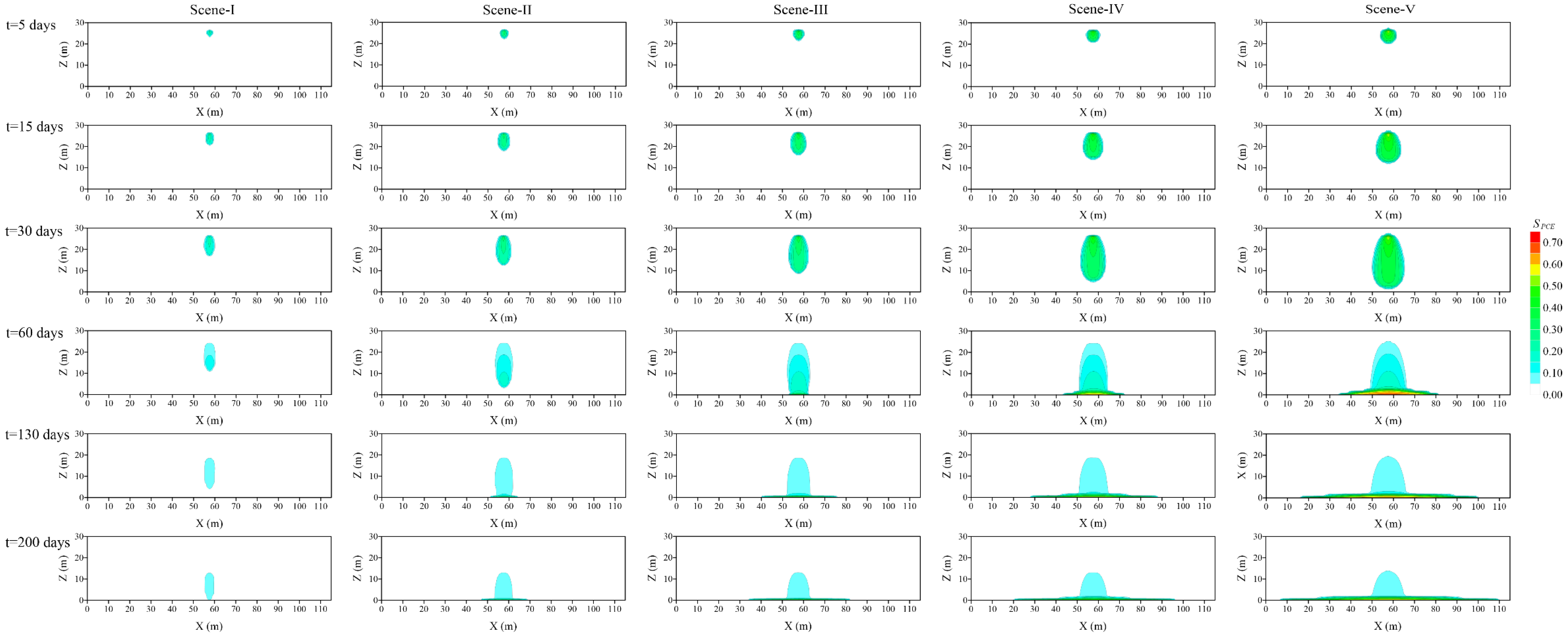
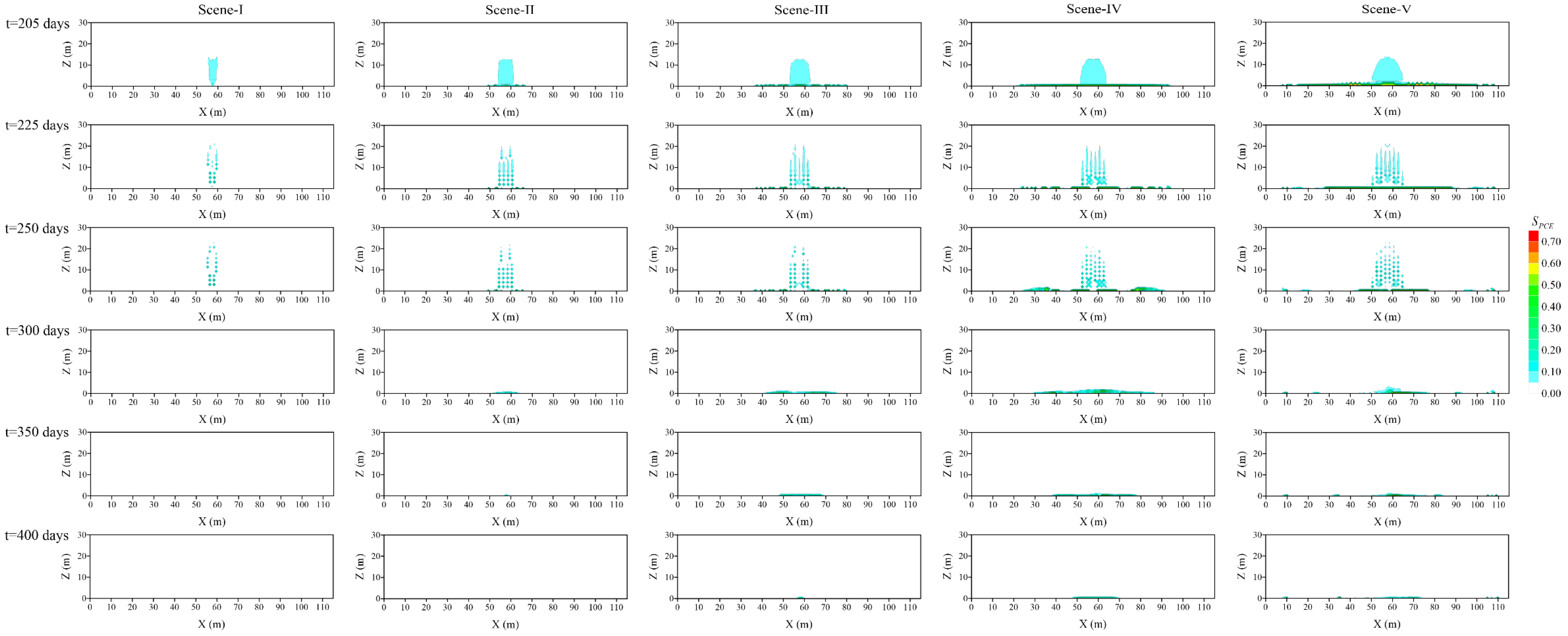
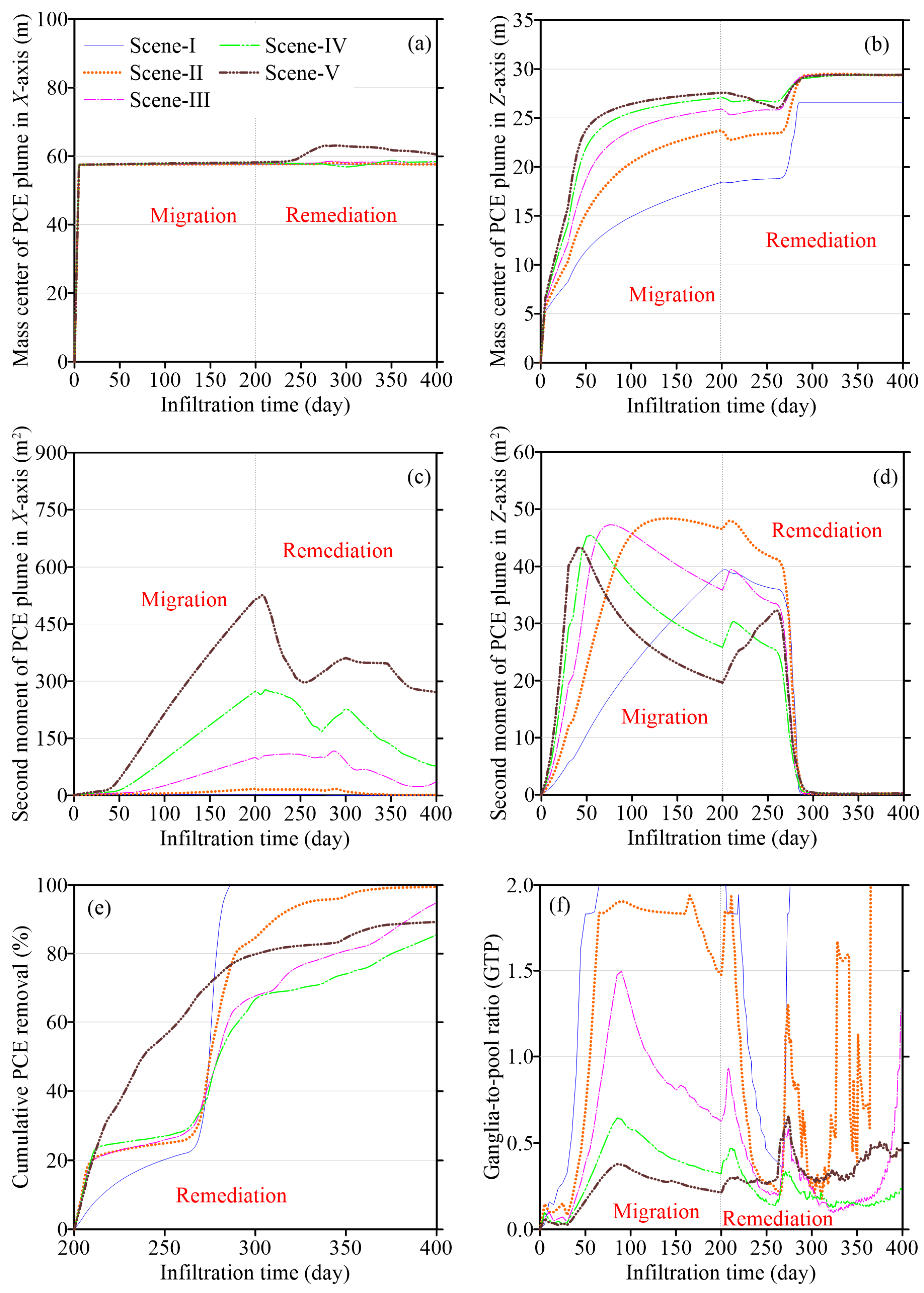
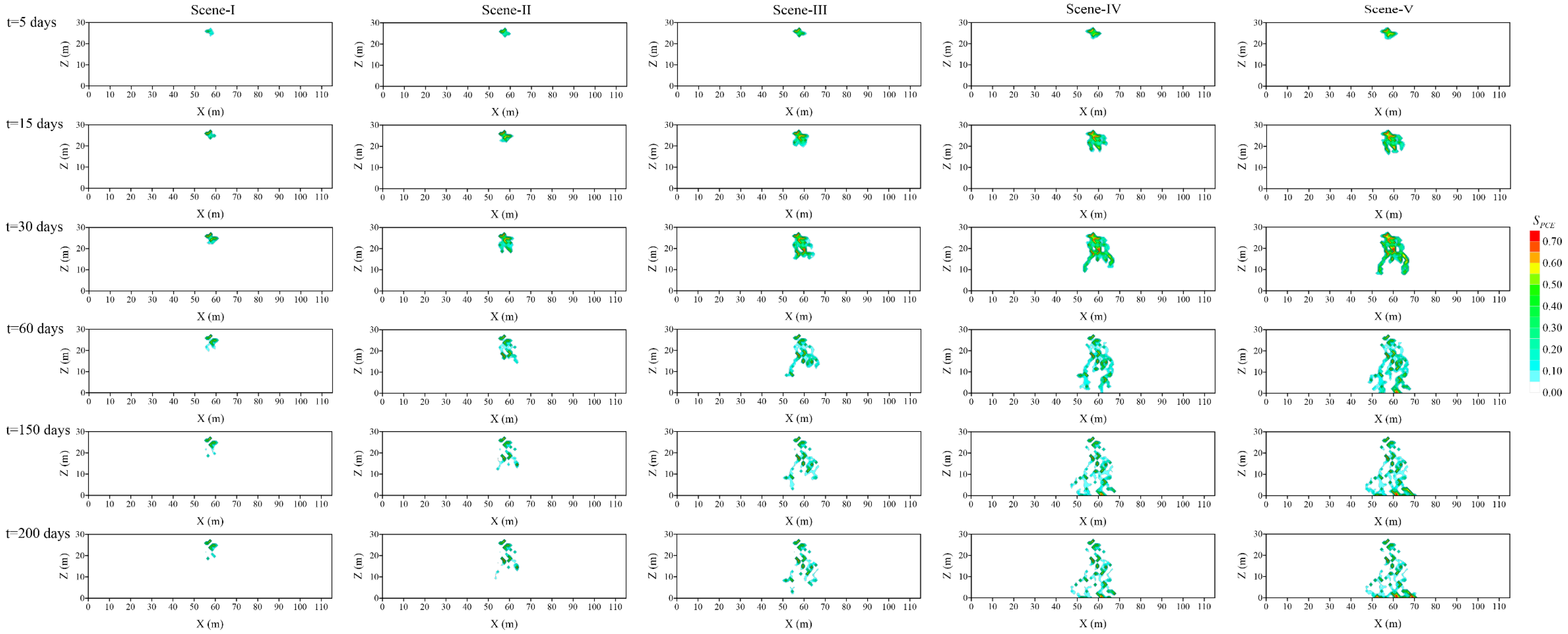
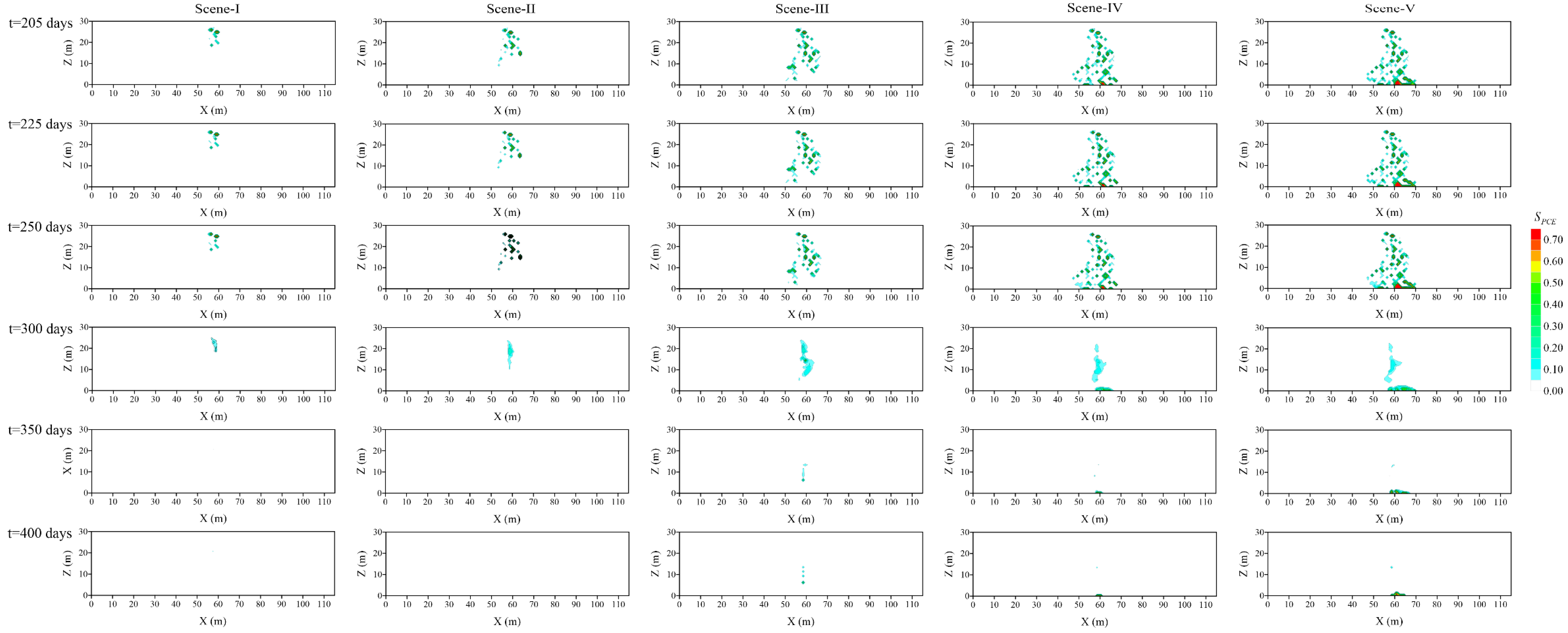
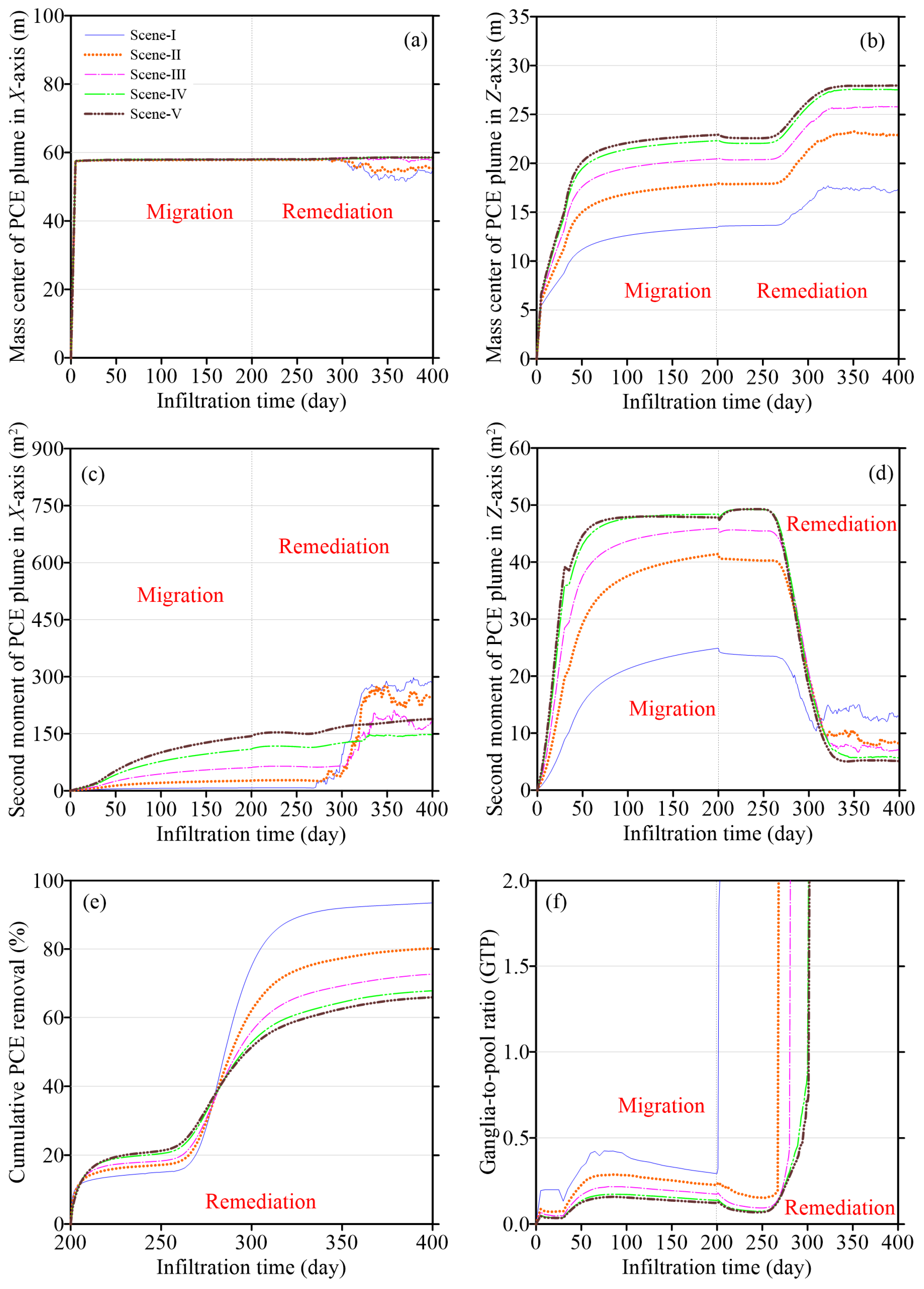

Disclaimer/Publisher’s Note: The statements, opinions and data contained in all publications are solely those of the individual author(s) and contributor(s) and not of MDPI and/or the editor(s). MDPI and/or the editor(s) disclaim responsibility for any injury to people or property resulting from any ideas, methods, instructions or products referred to in the content. |
© 2023 by the authors. Licensee MDPI, Basel, Switzerland. This article is an open access article distributed under the terms and conditions of the Creative Commons Attribution (CC BY) license (https://creativecommons.org/licenses/by/4.0/).
Share and Cite
Cheng, Z.; Lu, G.; Wu, M.; Hao, Y.; Mo, C.; Li, Q.; Wu, J.; Wu, J.; Hu, B.X. The Effects of Spill Pressure on the Migration and Remediation of Dense Non-Aqueous Phase Liquids in Homogeneous and Heterogeneous Aquifers. Sustainability 2023, 15, 13072. https://doi.org/10.3390/su151713072
Cheng Z, Lu G, Wu M, Hao Y, Mo C, Li Q, Wu J, Wu J, Hu BX. The Effects of Spill Pressure on the Migration and Remediation of Dense Non-Aqueous Phase Liquids in Homogeneous and Heterogeneous Aquifers. Sustainability. 2023; 15(17):13072. https://doi.org/10.3390/su151713072
Chicago/Turabian StyleCheng, Zhou, Guoping Lu, Ming Wu, Yanru Hao, Cehui Mo, Qusheng Li, Jianfeng Wu, Jichun Wu, and Bill X. Hu. 2023. "The Effects of Spill Pressure on the Migration and Remediation of Dense Non-Aqueous Phase Liquids in Homogeneous and Heterogeneous Aquifers" Sustainability 15, no. 17: 13072. https://doi.org/10.3390/su151713072





